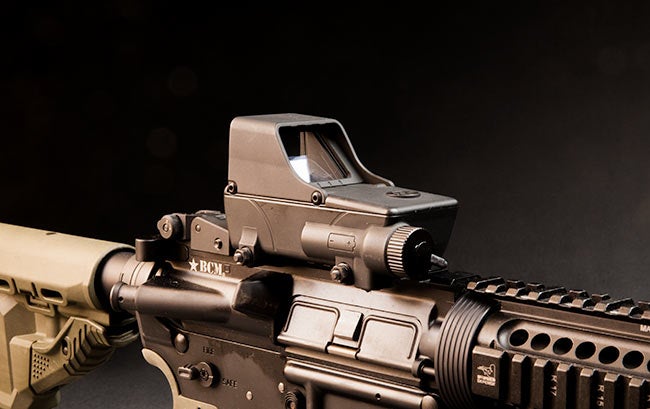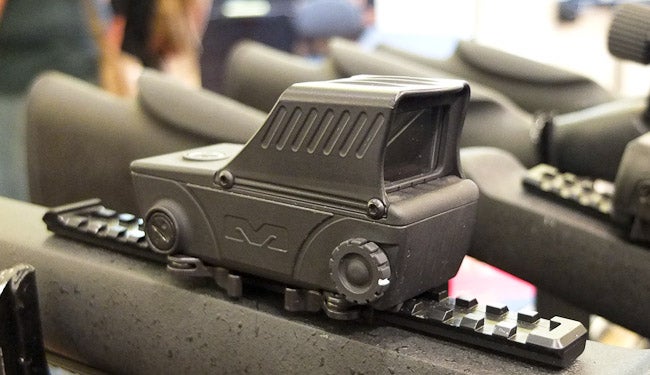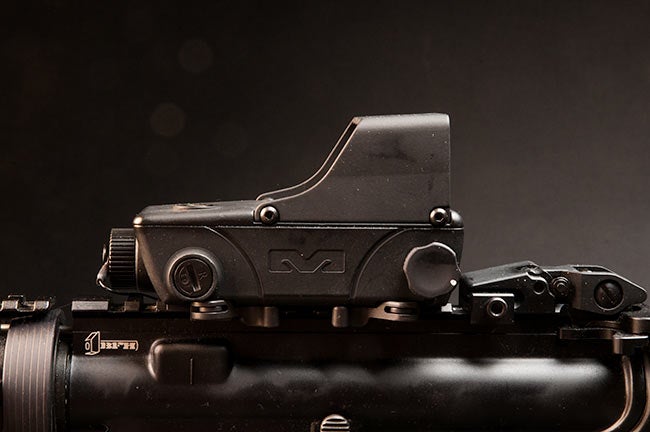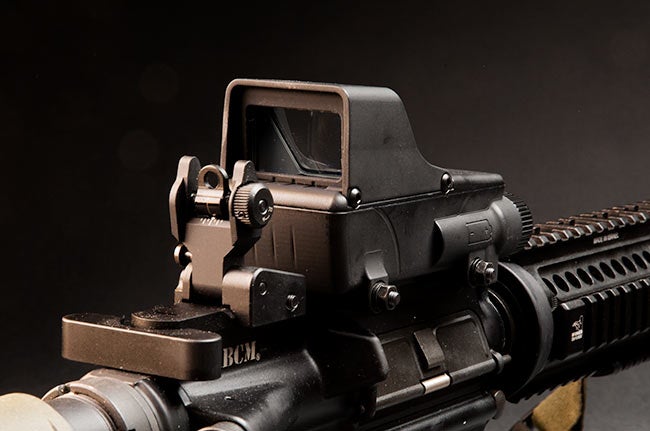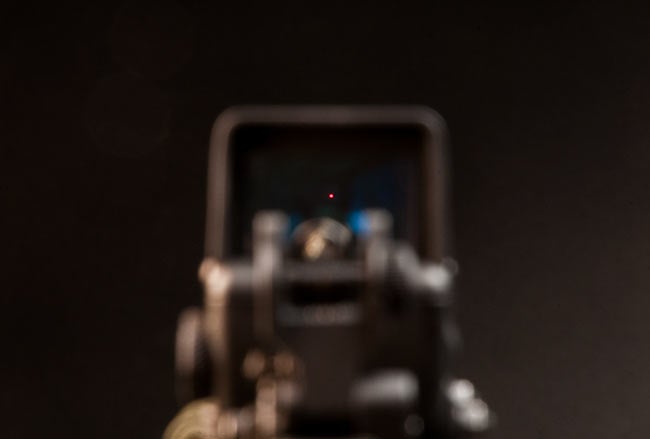Estás usando un navegador obsoleto. No se pueden mostrar estos u otros sitios web correctamente.
Se debe actualizar o usar un navegador alternativo.
Se debe actualizar o usar un navegador alternativo.
Israel fotos militares
- Tema iniciado Leutnant
- Fecha de inicio

The Israeli Defense Forces (IDF) were one of the first militaries to understand the importance of an optic equipped rifle for every infantryman. The standard reflex sight of the IDF is the Meprolight M21, but a select few in each unit are issued a specialized reflex sight with a built-in laser designator. The first in this new class of sights was the MARS (Multi-purpose Aiming Reflex Sight). The MARS integrated an AA battery-powered red reflex sight, dual laser designators and a tethered pressure switch for activation in a single unit.
A small number of MARS sights were acquired by the US military during the early days of the War on Terrorism and the US Marines used it in the furious close-quarter fights during the Battle of Fallujah. However, the MARS sight was quickly withdrawn from US service due to some severe design drawbacks. The MARS has a ruggedly built cast aluminum housing but this makes it a bit heavy at almost 16 ounces. The field of view is narrow for a reflex sight due to its smallish 25mm objective lens. The biggest complaint against the MARS was the short 200-hour battery life. Backup iron sight were out of the question since the MARS is too tall to allow for a proper co-witness.

The IDF isn’t happy with the MARS either, but they have retained it in service since it’s the only commonly available weapon mounted laser designator they have in inventory. I have been told that IDF is not buying any new MARS sights and their last order was many years ago. Meprolight was tasked by the IDF to develop a replacement for the MARS. In 2010, Meprolight released the Mepro MOR and it quickly became the favorite weapon sight of the IDF Special Forces.
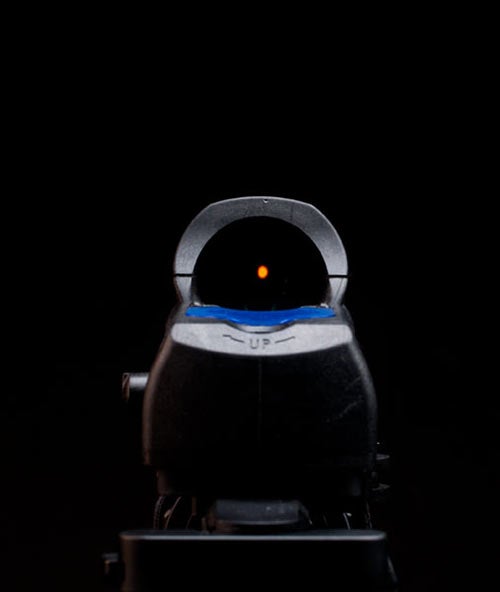
The Meporlight MOR features a 3 MOA dot which is on the large size with Aimpoint offering 2 MOA dots and EOTech offering 1 MOA dots. The 30mm objective lens on MOR offers a similar field of view as most of the reflex sights on the market. The lens uses a greenish coating like the M21 but the lens seems to be a bit brighter on the MOR.

The Meprolight MOR mounts to any 1913 style picatinny rail by way of its dual QD levers. On my AR-15, the MOR has a lower sight height than the MARS but it’s still too tall for an effective co-witness with the iron sights. The tops of the iron sights are barely above bottom of the lens. The Mako Group told me that the IDF is not concerned with using backup iron sight with the MOR since it offers redundancy from its dual reflex sights and lasers.
As indicated on the title, the Mepro MOR has a tri-powered illumination by fiber-optic, tritium and battery powered. It’s not the first optic to use tri-power. A better-known reflex sight that has a similar tri-power illumination is the Trijicon TX30 TriPower. The Trijicon is known to have similar drawbacks of of the MARS, namely a short battery life. It also suffers from dim tritium and light leak through its fiber optic collector when battery illumination is in use. Even Trijicon is admitting that the TriPower is not a successful product.
Internally, the Meporlight MOR is actually made up by two reflex sights stacking one in front of another, The front one is fiber-optic and tritium powered. Right behind that is the battery powered reflex sight. The use of dual AA batteries is for combat redundancy, since the Mepro MOR will function with just single AA battery. Even if the last battery die, there’s still the fiber-optic and tritium illumination.

The tethered pressure switch for laser activation can be mounted to the handguard of an AR15 but is designed to fit inside the Tavor’s handguard. The Tavor’s handguard features a special button cutout for concealment of the tether cable and allows for flush mounting the switch on the left side of the front handguard. The tether pressure switch is user replaceable and the different length versions are available.
Don’t try this with any of your laser. An very unique feature of the Mepro MOR is that it uses a single internal zeroing mechanism for both reflex sights and the laser designator, which eliminates the need to zero each component independently. The same two AA batteries power both the sight and the laser for thousands of hours.

The Mepro MOR on the new X95 bullpup. If you have an IDF version of the U.S. Tavor, you can check with the Mako Group to see if they can supply you with the special mount to adapt it to your rifle. Weight in at 15.8 ounces the Mepro MOR is hardly any lighter than the MARS sight that it suppose to replace.

The Mepro MOR with visible red laser is priced at $1200 and the dual red and IR laser model is $1600. The price is high but what you’re getting is two reflex sights and a laser designator all in one unit with triple redundancy. All three aiming systems are also all sync to a single impact point. Comparing to the ridiculously overpriced American-made $1000 Trijicon SRS and the $1200 Leupold LCO, the combat proven Meprolight MOR seems to be a bargain with twice the optics plus a laser too.
The Mako Group, the US importer of the Mepro MOR, is restricted to only allow the dual laser model for LE and military sales only. However, the restriction doesn’t applies to Mako’s reseller such as 7.62 Precsion and there’s a small additional discount on top of that too.
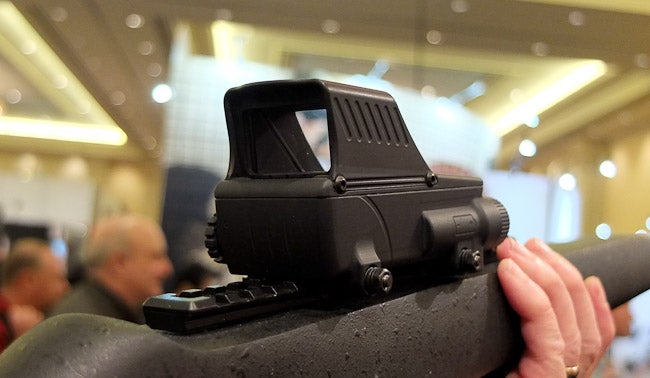
Esta mira me encanta.

Esta nunca me gusto..., me resulta muy chica.

Ya esta en pedo.

Que buena esta esa campera.
Última edición:
No hacen entrenamiento con los tanques Magach? (Aunque estén de reserva.. o están de baja definitivamente?)
Reserva SaludosNo hacen entrenamiento con los tanques Magach? (Aunque estén de reserva.. o están de baja definitivamente?)


Última edición:
Estos no son los tanques que disparan misiles desde detrás de la torreta???Reserva Saludos

Los Israelies pueden ver revistas de mujeres desnudas!!!..., toda una novedad.
Estos no son los tanques que disparan misiles desde detrás de la torreta???

Como ya se mencionó, la primera familia de tanques M60 llegaron a Israel en 1970-71. Un total de más de 1400 tal orden pasaron tanques de las FDI; el último fue desechado de la reserva en 2014-m. en Israel llamada los magos de M60-6; con el tiempo, han surgido las siguientes opciones y designaciones:
-"MAGOS-6"-M60 (a diferencia de la torreta de M60a1 y M60a3). Este es el mismo nombre utilizado para referirse a la M60 en General, todos los modelos.
-"MAGOS 6 Alef" (es decir, "magos-6a")-torrecilla del M60a1. En Israel la M60 y otros modelos han sido actualizado-nuevo comando torrecilla de la producción israelí, mejora del sistema de turbocompresor del motor, instale la armadura con bisagras, transición gradual a las pistas de toda de metal con terminales desarrollados ("espuelas"; similares a orugas tanque Merkava), aislando la piel en el barril cañón, etc..
-"MAGOS 6 apuesta" (es decir, "magos-6B")-M60a1 torrecilla (SUBIDA), es decir, M60a1 con mejor motor AVDS-1790-2 c AUMENTO (motor de fiabilidad mejorada seleccionado equipo), en lugar de las AVDS-1790-2A original. Además, el tanque tenía un mejor arma sistema de estabilización, así como tipo de orugas T142 con almohadillas de goma, mientras que del "Alef de MAGOS-6"-cuneiformes orugas tipo T97 menor anchura. Poco a poco, el motor y el estabilizador se ha mejorado en todos M60a1 torreta, es decir, "los MAGOS 6 Alef" han sido mejorada a un nivel "MAGOS 6 apuesta". Como un nombre de consecuencia "MAGOS 6 Alef" ha ido fuera de uso. Con el paso del tiempo perdido y la diferencia en los tipos de gusanos.
-"MAGOS 6 Bet Gal"-"MAGOS-6 apuesta" con el nuevo LMS "Gal" ("ola"), sobre la base del tanque de Merkava LMS "Matador". Además, cambia la configuración de los bloques y la armadura de la torreta instalada una nueva canasta, aumento de volumen.
- "MAGOS-6 Bet Gal BATASh"-opción" MAGOS 6 Bet Gal "con potente reserva pasiva adicional Torres y pantallas de casco y de lado. El motor de 750 caballos de fuerza original substituido por un más de gran alcance, 908 HP en la Web para este modelo se encuentran "MAGOS-MAGOS" y "8-7 d".
-"MAGOS 6 Beth Bases"-similar a los "MAGOS 6 Bet Gal", pero desde SUO "Bases" (como "tanque Merkava-3") en lugar de lo LMS "Gal". Antes de esto, un pequeño número de tanques había actualizado nivel "MAGOS 6 apuesta".
-"MAGOS 6 Gimel" (es decir, "magos-6C")-M60a3.
-"Reis MAGOS-6" (es decir, "magos-6R)-M60 (a diferencia de la torreta de M60a1 y M60a3) con un nuevo estabilizador de arma ("como apuesta de MAGOS-6), motor actualizado al nivel de las AVDS-1790-2AG. La principal diferencia con el AVDS-1790-2AG generador AVDS-1790-2A con amperios amperaje 650 en vez de la original 300, para satisfacer la demanda creciente para el sistema de estabilización de pistola eléctrica (motor calificadas en el sistema hidráulico de 10 HP, servo, pistola de giro y en consecuencia- y LMS).
-"Reis MAGOS 6 *" (es decir, "magos-6R *")-"Reis MAGOS 6" preparado para instalar nuevo LMS "Nahal Oz" (ANA), pero no cuentan con este sistema.
-MAGOS-6 "meme" (es decir, "los magos 6 m")-"Reis MAGOS 6 *" con LMS "Nahal Oz".
- "Modernización de MAGOS-7pulgadas de profundidad de la M60 (es decir, "los MAGOS 6 Meme" LMS-"Nahal Oz"). Nuevo chasis de torre pasiva adicional de la reserva, pantallas ortovye, 750 caballos de fuerza diesel AVDS-1790-2AG sustituido por AVDS-1790-5A de 908 HP con arrancador automático, carga 6 dos humo cohete propulsado granadas (en lugar de la anterior 10-carga), etc..
-"MAGOS-8"-además de la skazanogo sobre la confusión con "MAGOS 6 Bet Gal BATASh", hay informes que lo planearon llamar "MAGOS-7" con el 120 mm pistola, básicamente lo que se ofrece para la exportación como "Sabra", ver. a continuación.
M60 14 brigada, también, Sinaí, 1979; tanques aparecieron "topes" para el montaje de elementos de armadura reactiva explosiva "Blazer":

Ibíd., al mismo tiempo:

Siendo la misma:
Los libaneses; Magahi lengua 6 jamba de Beth:




El barrio de Beirut, Julio 1982-Guo:


"MAGOS-6 Bet Gal BATASh "-opción" MAGOS 6 Bet Gal "con potente reserva pasiva adicional Torres y el casco, lado pantallas (no oficial, por lo tanto, otro nombre de este modelo" MAGOS 6 Memugan "-"protegida"). Un rasgo característico es la configuración de las torres de reserva adicionales, dándole la forma de "tarelkovidnaja". El motor de 750 caballos de fuerza original substituido por un más de gran alcance, 908 HP en la Web para este modelo se encuentran "MAGOS-MAGOS" y "8-7 d". La palabra "BATASh" significa "bitahon shotef", es decir, "que día a día la seguridad". Generalmente la palabra "BATASh" entender la protección de las fronteras relativamente pacíficas, pero en este caso, lo que significaba era trabajo diario AOI en el Líbano (hasta el retiro de tropas en mayo de 2000 г.)-este modelo fue creado. Otras fuentes de este tanque conocido como "MAGOS 6 KASAG" aquí "KASAG" es una abreviatura de las palabras "Kav Sagol'" ("línea púrpura")-llamado zona de seguridad de la frontera norte AOI en el Líbano. Esta versión ha sido actualizado una pequeña cantidad de tanques "MAGOS 6 Bet Gal".
Oficial operativo Rota "meme" 9-th b-on con el equipo cambia el balanceador ("zroa") después de ejercicios preparatorios antes de entrar en Líbano. año 1999-th. A la derecha es el nuevo equilibrador (ya montado). Nota oficial se encuentra en la herramienta para sacar torsionov. En "MAGOS-BATASh" estaba parado barras de torsión reforzadas.

OP (mucav) "la ducha", lugar limpio eficiente, frontera con el Líbano. Comandante del tanque prepara un tanque para una noche hacia fuera. Nota el buzón que está detrás de su escotilla.Hay guardar tarjetas y accesorios. Después de un par de horas después de disparos del tanque encontrar éxito 120 mm minomjotnoj minas en la torre. Sin consecuencias, además de belleza. Uno de los fragmentos, que había cavado desde el exterior coche, he conseguido hasta ahora.

OP (mucav) "la ducha". Tanque va en trabajo nocturno. Combatientes en la foto te enojes que dispara antes de lucha de la liberación es un presagio sobre la foto, que puede aparecer en el periódico de mañana (marco negro).

"Pared defensiva de la operación" (2002), Ramallah:

Al mismo tiempo:

Gas, 2003:

Temas similares
- Respuestas
- 2K
- Visitas
- 98K
- Respuestas
- 81
- Visitas
- 4K
- Respuestas
- 257
- Visitas
- 12K

